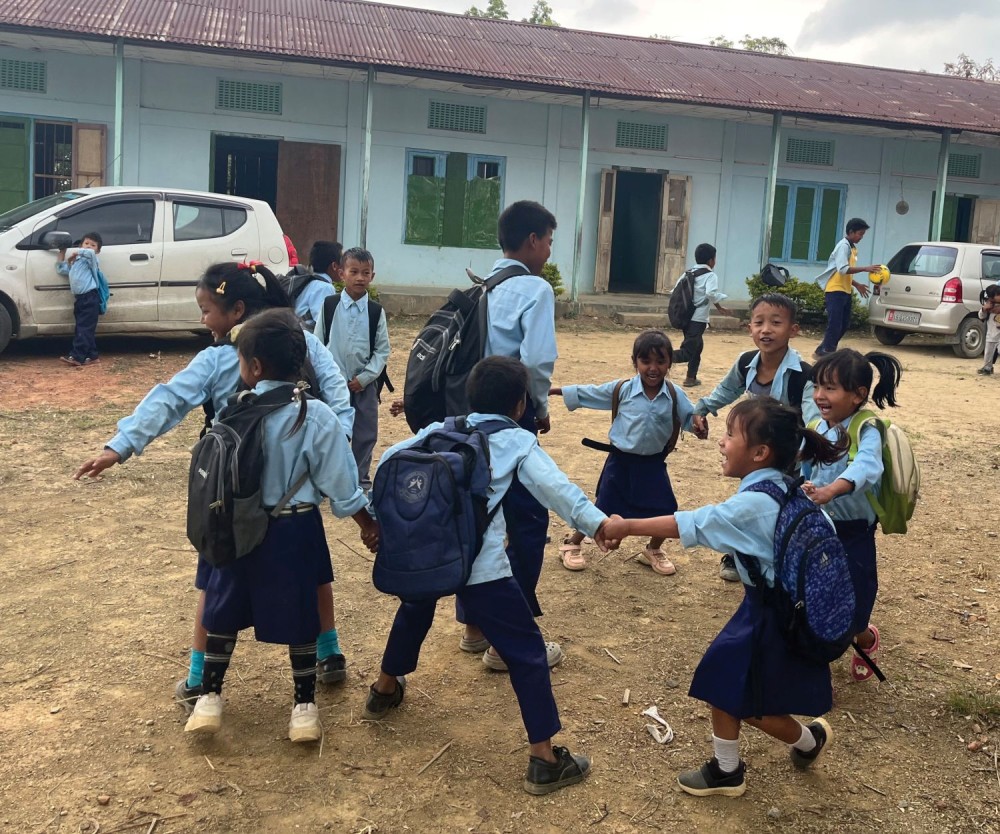Students enjoying play time after classes at GMS Tsosinyu in Tseminyu district. (For representational purpose only | Photo Courtesy: NECTAR Nagaland)

Nagaland govt schools mirror a broken system, plagued by apathy, infrastructure deficits and teacher absenteeism, reveals a Morung Express opinion poll
Morung Express News
Kohima | May 3
A recent opinion poll conducted by The Morung Express has highlighted deep-rooted and systemic issues plaguing government schools in Nagaland. The weekly poll, which sought public insight into the consistent underperformance of students in the Nagaland Board of School Education (NBSE) examinations, revealed a critical lack of trust in the education system, plagued by neglect, infrastructure deficits, teacher absenteeism and policy failures.
The strongest criticism pointed to entrenched bureaucratic indifference, with 42% of respondents identifying systemic apathy as the root cause. Participants voiced frustration over what they described as an entrenched culture of indifference in the education bureaucracy.
“A bug named- Apathy. Blame it on the bug Apathy, a silent intruder that’s made itself very comfortable in our State Education Department. It loiters in the Directorate, snoozes with district officers, sips chai with project directors, and even gets VIP seats in budget meetings. The real pandemic isn’t underfunding. Its apathy dressed in official badges,” stated one respondent.
The same individual further remarked: “While classrooms patiently wait for supplies and children gaze at blank blackboards, apathy thrives, is peaceful, and is frequently facilitated.”
This sentiment resonated with other respondents who argued that unless there is a transformation in the attitudes within the department, lasting change will remain out of reach.
The second most cited concern (26%) was the poor state of school infrastructure, which respondents said hampers both teaching and learning. “How can students learn about subjects like Science without labs? Where are the libraries? The absences of such infrastructure have resulted in poor learning environment and absence of enabling conditions for holistic education,” a respondent stated.
Another respondent added, “Proper smart classrooms, computer laboratories, science laboratories and library with library professionals could transform government schools.”
Although only 11% identified lack of qualified teachers as the main problem, there was widespread criticism of teacher absenteeism and a lack of commitment. “No matter how much the people fight, there are still many government teachers who do not come for their work at all or some doesn’t take it serious,” said a participant.
The use of proxy teachers was flagged as a serious issue. “Despite SMILE app being launched many teachers are still keeping others as their replacement playing with student’s education which is heartbreaking.”
The issue of student dropout and attendance was highlighted by 21% of participants. Many respondents linked this to poverty, household responsibilities, and a lack of motivation within schools.
“Most of the children sent to government schools are either helper in someone’s house or some who cannot afford private education,” shared one citizen.
The no-detention policy was another contentious topic. While designed to reduce exam pressure, it was seen as having unintended consequences. “Students keep failing but are promoted anyway. By the time they reach higher classes, they can’t cope with board exams,” said a respondent.
Several respondents cited language barriers as a major hurdle in academic performance. Concerns were raised over inconsistent use of English in the classroom and the impact this has on students' ability to engage with exam material. “English language should be made 100% compulsory in schools,” read one comment.
“Government teachers often explain in local dialects or Nagamese, which helps students understand initially. But in exams, students struggle with standard-language questions.”
Outdated teaching approaches were also flagged. “Private schools focus on conceptual learning, while government schools still emphasize memorization,” one respondent noted.
A number of respondents pointed to the lack of trust in government schools among government officials themselves. “No government employee or politician sends their children to government schools.”
Another suggested: “Make it compulsory for every government employee to send at least one child to a government school.”
Despite the bleak outlook, there were signs of hope. Some respondents acknowledged improvements since the introduction of the SMILE app, which monitors teacher attendance. “Only since 2025, with the SMILE app, have teachers become somewhat regular. Before that, proxy teachers and incomplete syllabi were the norm,” shared one participant.
There were also calls for rejuvenating the teaching workforce. “Transfer teachers who have been in the same school for over a decade. Bring in young, dynamic educators who can adapt to modern teaching methods,” urged another respondent.
As one participant summarized that the issues affecting Nagaland’s government schools are multi-layered and interlinked. “Every aspect is equally to be blamed. The main drawback is the mindset of the people. Change the mindset, and you’ll see the change.”






